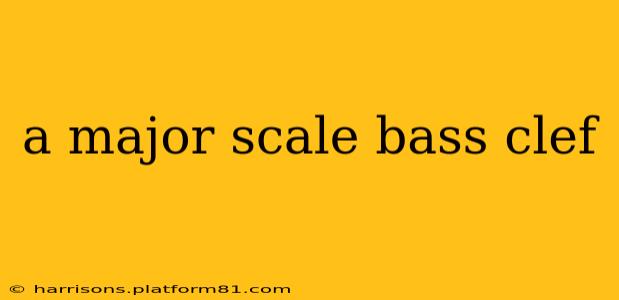The bass clef, with its distinctive "curlicue" shape, is home to the lower register of musical notation. Understanding how scales are constructed within this clef is crucial for bassists, cellists, and other musicians who play instruments in this range. This guide will break down the A major scale in bass clef, offering a comprehensive understanding for musicians of all levels.
What is a Major Scale?
Before diving into the bass clef, let's briefly review what defines a major scale. A major scale is a seven-note musical scale that follows a specific intervallic pattern: whole, whole, half, whole, whole, whole, half. This pattern creates a characteristic bright and cheerful sound.
The A Major Scale: Notes and Intervals
The A major scale consists of the following notes: A, B, C#, D, E, F#, G#, A. Let's break down the intervals:
- A to B: Whole step
- B to C#: Whole step
- C# to D: Half step
- D to E: Whole step
- E to F#: Whole step
- F# to G#: Whole step
- G# to A: Half step
Writing the A Major Scale in Bass Clef
Now, let's translate this into bass clef notation. While the notes themselves remain the same, their position on the staff changes depending on their pitch. Here's how the A major scale would appear:
(Insert image of A major scale in bass clef here. This would ideally be a visually clear, high-quality image showing the notes clearly on the bass clef staff.)
Notice how the notes span several octaves within the bass clef. The lower A is often found near the bottom of the staff, while higher notes ascend towards the treble clef's range.
Frequently Asked Questions (FAQ)
Here are some common questions about the A major scale and its notation in the bass clef:
How do I practice the A Major Scale in Bass Clef?
Practicing the A major scale effectively involves several approaches. Start slowly, ensuring each note is played clearly and accurately. Gradually increase your tempo while maintaining accuracy. Try playing the scale ascending and descending, and experiment with different rhythms and articulations (e.g., legato, staccato). Use a metronome to develop your timing and rhythmic precision. Focus on smooth transitions between notes to create a fluid and musical performance.
What are some common fingerings for the A Major Scale on bass instruments?
Fingerings for the A major scale will vary depending on the instrument. Consulting a method book or teacher specific to your instrument will provide the most accurate and efficient fingerings. Experimentation is key to finding what feels most comfortable and produces the best tone.
Are there different ways to write the A Major Scale in the bass clef?
While the notes themselves remain constant, the octave in which the scale is written might vary depending on the musical context. The scale could start on a lower or higher A, adapting to the overall pitch of the piece.
What are some pieces of music that prominently feature the A Major Scale in the bass clef?
Many classical and contemporary compositions utilize the A major scale in the bass clef. Specific examples often depend on the instrument being used. Searching for bass clef sheet music online, or consulting with your music teacher, will unveil many musical pieces featuring the scale.
This detailed guide provides a thorough understanding of the A Major scale in the bass clef. Remember that consistent practice and a good understanding of music theory will help you master this fundamental scale.
